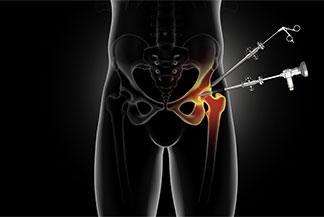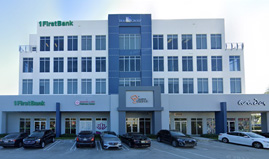Hip arthroscopy is a minimally invasive surgical procedure with the potential advantages of faster recuperation than traditional open surgery of the hip. Depending on the extent of problems in the hip and the type of surgical procedure you had, your recuperation times and return to functional activities may differ.
Patients often inquire about what they can expect after having undergone hip arthroscopic surgery. Here are a few tips Dr. Hommen has to help ensure a quick and successful recovery.
Same Day Procedure.
The majority of hip arthroscopic procedures can be performed as an outpatient surgical procedure. This means that you are able to go home on the same day as your surgical procedure. The team of nurses and anesthesiologists are skilled at delivering specialized care focusing on maximizing the outpatient surgical experience while minimizing unwanted side-effects such as nausea, grogginess, and pain after surgery.
What Kind of Anesthesia is Used During Hip Arthroscopy?
A combination of different anesthetic techniques can be used to perform hip arthroscopy. A long-acting nerve block may be administered prior to surgery to numb the hip region. General anesthesia is typically used during the procedure. After the procedure, local anesthetics may be injected around the surgical site.
What Level of Pain Can I Expect After Hip Arthroscopy?
As soon as the procedure is over, you will awaken and your hip with remain under the anesthesia effects of the nerve block and local anesthetic injections. This allows the majority of patients to use only acetaminophen (Tylenol) and an anti-inflammatory such as ibuprofen after surgery. Most patients do not require opioid medications after they have been discharged home. Dr. Hommen recommends that you continue to use acetaminophen and anti-inflammatory medications for 2 to 3 days after the procedure to minimize the inflammatory phase normally seen after surgery.
What Other Medications are Prescribed or Recommended After Surgery?
Dr. Hommen typically recommends aspirin or other blood thinners such as Eliquis or Xarelto to lower the risk of blood clots after surgery. In order to reduce the risk of heterotopic bone (a scar tissue formation of bone within the muscle around the hip) after hip arthroscopy, you may be prescribed an anti-inflammatory medication such as indomethacin, ibuprofen, or naproxen. If you are prone to nausea, you may be prescribed a medication to reduce nausea after surgery.
What To Arrange Prior to Surgery:
Groceries:
Consider stocking up on a week’s supply of groceries prior to your surgery to limit any unnecessary trips to the grocery store. Healthy foods that promote healing include: 1) Fruits with antioxidants and vitamin C (blueberries, raspberries, strawberries, goji berries, blackberries, grapes, pomegranates), 2) vegetables with vitamin A and C (carrots, sweet bell peppers, broccoli, cabbage, brussels sprouts), 3) fats (avocados, olive oil, nuts, seeds), 4) dark leafy greens (kale, spinach, romaine lettuce), 5) meats for iron and protein (poultry, seafood, eggs, beans, lentils, nuts), 6) probiotics (yogurt, kimchi, kefir, sauerkraut), 7) whole grains for energy and fiber (quinoa, wild rice, steel cut oats, whole-wheat or rice sourdough breads), 8) and plenty of water.
Constipation:
It is normal to miss a few bowel movements in the first 2 or 3 days after surgery. Eating foods rich in fiber (prunes, vegetables, beans, lentils, whole-grain breads, cereals, wheat bran) and drinking plenty of water are helpful after surgery. Psyllium powder mixed in water can also be supportive if you are prone to constipation. The use of opioid pain medications after surgery is a frequent cause of constipation. Therefore, we recommend transitioning to nonopioid pain medications as soon as possible. Probiotic foods can help restore the normal gut bacterial flora after surgery.
Medications:
It is also beneficial to stock up on any over-the-counter post-operative medications such as acetaminophen and anti-inflammatories as well as any prescription medications you normally take. Dr. Hommen will likely recommend the use of 325 mg strength acetylsalicylic acid (Aspirin or Ecotrin) for 4 weeks after surgery (if you are not allergic). Additionally, a few opioid pills may be prescribed after surgery which you will need to fill in a pharmacy after surgery.
Make your house crutch or walker-friendly:
Be certain to move any throw rugs, cords, or other obstacles away from the paths you will take from the bed to the bathroom, living room to the kitchen etc. If your bedroom is on a second or third floor, or if you live in a walk-up, make arrangements to minimize the use of stairs after surgery. This may mean moving your bed to the first floor or temporarily living with a family member or friend for the first few days after surgery to minimize the risks of falls and limit any unnecessary activity after surgery. Scheduling a physical therapy session prior to surgery can help teach you the appropriate ways to use these devices and minimize the risks of falls and onset of aches and pains in other joints.
Three-in-one commode, shower chair, and an elevated chair:
Hip arthroscopy may make everyday activities a little more difficult, such as using the toilet and showering. Consider the use of a 3 in 1 commode as a bedside commode, an elevated toilet seat, and as a toilet safety frame. These are especially helpful after hamstring and gluteus tendon repairs. A shower chair may also be useful after surgery, especially if you have weight bearing restrictions on the lower extremity. Sitting on a low chair may place the hip in higher degrees of flexion. This may impinge the repaired labrum in the front of the hip or tension the gluteus or hamstring repairs after surgery. This can be avoided by using an elevated chair after hip arthroscopy. Placing one of two firm pillows on a chair may help create a comfortable elevated chair.
CPM Machine
Dr. Hommen may prescribe a continuous passive motion (CPM) machine to help move the hip while you are seated or laying in bed. These are most useful after impingement resections, labrum repairs/reconstructions, and other cartilage procedures. A CPM machine is usually not recommended after gluteus or hamstring tendon repairs. Obtaining an authorization for a CPM machine may be dependent on your particular insurance provider, however units can be rented for 2 weeks after surgery.
Ice Pack:
Ice packs in the form of gel packs are a convenient way to provide cold therapy to your hip after surgery. Specialized cryotherapy units can also be rented for 2 weeks, however some insurance providers may cover the expense of the unit. Ice can be used for 30-45 minutes every hour while awake during the first 72 hours after surgery to reduce the acute inflammatory phase after surgery.
You Will Need Some Help After Surgery
Having a family member or a friend available to help you for the first week after surgery may be very helpful. They will drive you home after surgery as you will not be allowed to drive yourself home due to the effects of general anesthesia. They may also be helpful in assisting in household duties such as cooking and cleaning. If you are a student, let your school, college or university know that you may require some days off and inquire if you may have assistance in getting to class and with parking. Informing your athletic trainer and athletic director may also be helpful for school and college athletes. The small keyhole incisions used at the time of arthroscopy will require careful monitoring after surgery to ensure there are no signs of infection. Given the location and small size of these incisions, having someone monitor the incisions may be helpful in the first few weeks after surgery.
Hip Brace and Crutches/Walker
Dr. Hommen may recommend a postsurgical hip brace to protect any repairs, reconstructions, or impingement resections for 2 to 3 weeks after surgery. It is recommended that you comply with the use of the brace in order to have a successful outcome. Weightbearing restrictions to the surgical extremity may also be recommended with varying lengths of time depending on the type of procedure performed and extent of hip issues noted at the time of surgery. Hip impingement and labrum repairs are usually braced for 3 weeks while gluteus and hamstring repairs may require 6 weeks. The use of a walker or crutches is therefore paramount in order to allow the structures to heal successfully and to help off-load the repair and healing structures. Dr. Hommen recommends that you remain relatively active after surgery and to avoid prolonged periods of bed-rest during the day-time.
Hip Bandages and Dressings
The keyhole incision sites will be covered with absorptive gauze after surgery. It is advisable to keep these dressings clean, dry, and intact and that you sponge-bathe initially. Usually, these dressings are removed 72 hours after surgery by the patient or caretaker at which point you may resume showers. Avoid submerging the incision sites in a bath, pool, jacuzzi, or sauna until 3 or more weeks after surgery. You may notice some normal swelling or bruising around the incision sites for the first week after surgery. For any postsurgical questions or concerns, instructions will be provided as to how to contact the office.
Driving Restrictions After Surgery
Driving after surgery may place the hip repair at risk. Labrum and other cartilage procedures and impingement resections are usually recommended to not drive for 21 days after surgery. Driving is restricted for at least 6 weeks for hamstring and gluteus tendon repairs. Be especially careful if you have a car with low bucket seats, an elevated car or truck, or if your car has manual transmission.
Importance of Physical Therapy After Surgery
Dr. Hommen will provide specific rehabilitation instructions for your physical therapist according to the surgical procedure performed and the hip findings noted at the time of surgery. A customized and detailed rehabilitation plan will be tailored to your surgical procedure, general health, as well as your goals for returning to activities and sports. Your physical therapist is therefore vital in progressing you through the different phases of the recuperation protocol, from the initial phase of reducing post-surgical inflammation, to the later phases of strengthening and flexibility, and gradual return to activities. It is therefore important to keep your physical therapy appointments and to follow your home exercise instructions. Missing physical therapy appointments or overdoing your post-surgical therapy is not recommended and may be harmful. Dr. Hommen recommends that you start therapy within 48 hours from your surgery.
About Dr. Hommen
Dr. J. Pieter Hommen is a board-certified orthopedic surgeon who has been performing hip arthroscopy in Miami since 2005. He has served as a Master Instructor of hip arthroscopy to orthopedic surgeons and residents and is involved in academic research.
For more information about hip arthroscopy and what it can mean for you, schedule an appointment with Dr. Hommen today. Call the office (305-520-5625) or book your visit online.














